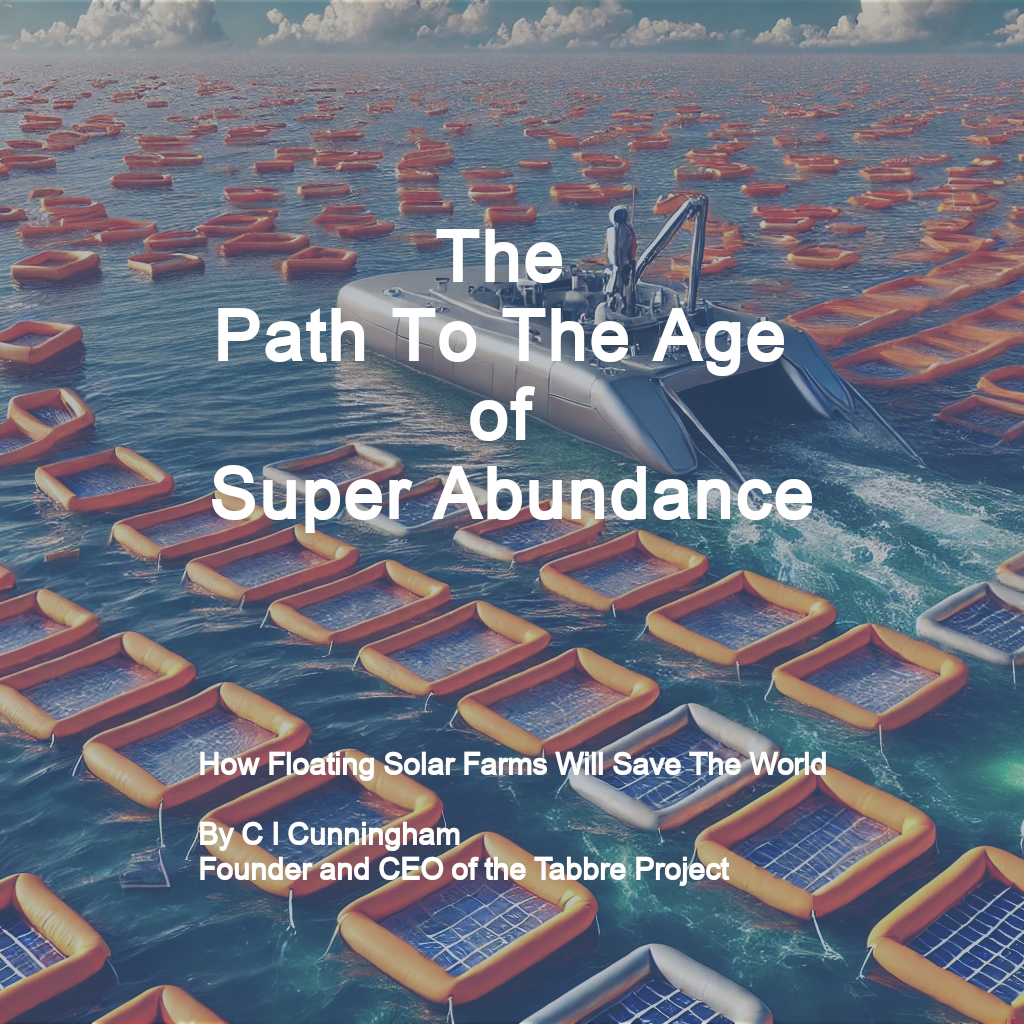
Part 1: The Problem – A World at a Crossroads
Chapter 1: The Energy Paradox
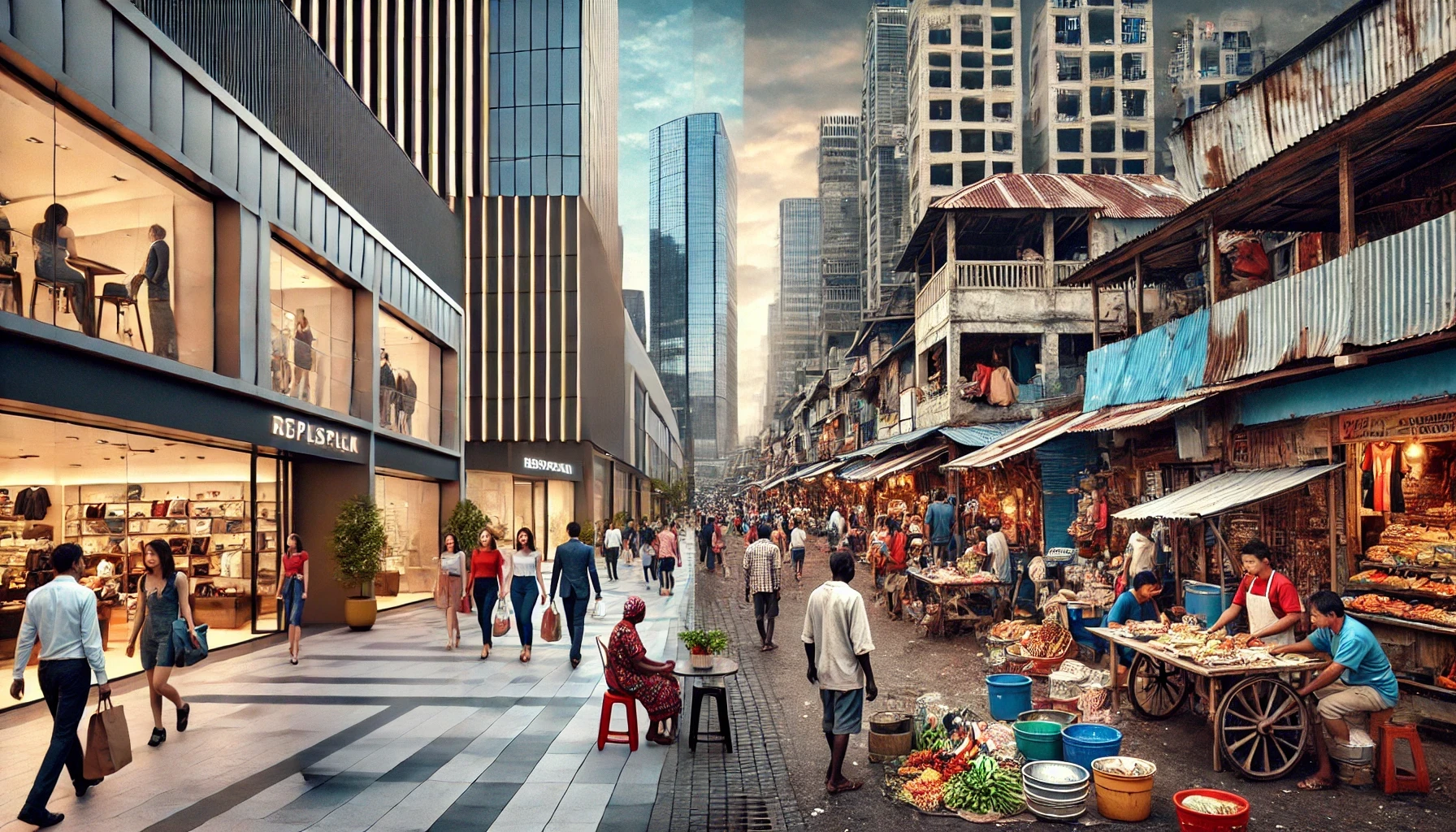
The hum of electricity, the roar of a jet engine, the glow of a smartphone screen – these are the sounds and sights of modern life, all powered by an invisible force: energy. We take it for granted, flicking a switch without a second thought. But this seemingly limitless power comes at a steep price, a price our planet and its most vulnerable inhabitants are paying every single day. We are living in an energy paradox: we need ever-increasing amounts of energy to thrive, yet our current methods of obtaining it are pushing us towards ecological disaster and exacerbating global inequalities.
Imagine a young girl in rural Africa, walking for hours each day to collect firewood for cooking, her education sacrificed for the basic necessity of fuel. Picture a family in Bangladesh, their home repeatedly flooded by rising sea levels, driven by the carbon emissions from distant power plants. Think of communities across the globe ravaged by increasingly frequent and intense heatwaves, droughts, and wildfires – all fuelled by a warming planet. These aren't abstract scenarios; they are the human faces of the energy paradox.
For decades, we've relied on fossil fuels – coal, oil, and natural gas – to power our world. These fuels, while energy-dense and relatively cheap to extract (at least initially), are a finite resource, and their burning releases billions of tonnes of carbon dioxide into the atmosphere, trapping heat and driving climate change. The consequences are no longer a distant threat; they are unfolding before our eyes. Coastal communities are disappearing, delicate ecosystems are collapsing, and extreme weather events are becoming the new normal.
But the problem isn't just environmental. The current energy system is deeply unequal. Billions of people lack access to reliable, affordable electricity, hindering their economic development, limiting their educational opportunities, and impacting their health and well-being. Energy poverty traps generations in a cycle of hardship, while wealthy nations continue to consume a disproportionate share of the world's resources. This disparity fuels social unrest and resource conflicts, as communities compete for dwindling supplies of fossil fuels.
Even the promise of "clean" energy – solar, wind, and other renewables – hasn't fully resolved the paradox. While these technologies have advanced rapidly, they face significant hurdles. The sun doesn't always shine, and the wind doesn't always blow. This intermittency requires expensive and often inefficient solutions for energy storage, driving up the overall cost and making it difficult for renewables to compete with the established fossil fuel giants. The expense of existing renewable energy schemes is a catastrophe for the less well off. Net Zero policies are simply making the problem worse.
We are at a crossroads. We can continue down the path of unsustainable energy consumption, risking irreversible climate damage and perpetuating global inequalities. Or we can choose a different path, a path towards energy abundance – a future where clean, reliable, and affordable energy is available to everyone, powering a more just and prosperous world. A path that embraces the ingenuity and innovation that defines our species and breaks out of the Zero sum thinking that has defined it.
What if we could harness the boundless energy of the sun, not in small, scattered patches, but on a truly massive scale? What if we could overcome the limitations of current renewable technologies and create a system that is both environmentally sustainable and economically viable? What if we could not only solve the climate crisis but also lift millions out of poverty and create a more equitable global society? What if we could have abundant, clean energy and a more equitable world?
Chapter 2: The Climate Clock is Ticking – And It's Set to LOUD!!
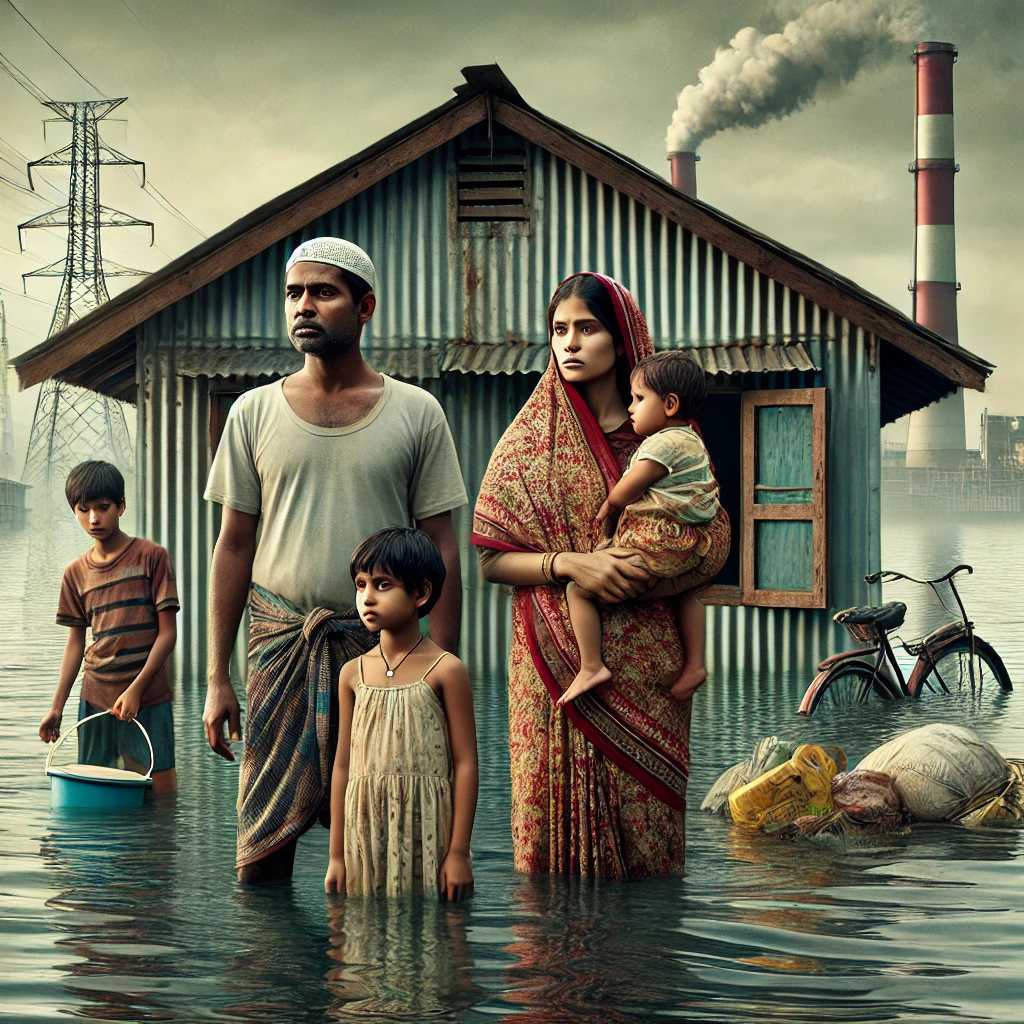
Forget slow-motion disaster movies. Climate change isn't some distant threat; it's the hyper-speed reality we're living now. The Earth isn't just warming; it's sending out distress signals, and they're getting harder to ignore. We're talking wildfires raging across continents, supercharged hurricanes slamming coastlines, and ancient glaciers vanishing before our eyes. This isn't about polar bears anymore (though they're in serious trouble); it's about us.
The science, frankly, is terrifyingly simple. We've been digging up and burning fossil fuels – coal, oil, gas – for over a century, releasing a colossal blanket of carbon dioxide (CO₂) into the atmosphere. Think of CO₂ as a heat-trapping greenhouse gas. The sun's energy gets in, but less of it can get out. The more CO₂ we pump into the atmosphere, the thicker that blanket gets, and the hotter the planet becomes.
And it's not just CO₂. Methane, another potent greenhouse gas, is leaking from thawing permafrost and intensive agriculture, adding fuel to the fire. We're not just turning up the thermostat; we're cranking it to eleven.
The Intergovernmental Panel on Climate Change (IPCC) – basically, the world's climate science dream team – isn't mincing words. Their reports, backed by thousands of scientists and mountains of data, confirm that human activity is unequivocally the cause of this warming trend. We're not dealing with natural fluctuations; we're dealing with a human-made crisis.
And the consequences? They're already here. We're seeing "once-in-a-century" floods becoming annual events. Heatwaves are turning cities into ovens. Droughts are withering crops and sparking conflicts over water. Entire ecosystems are on the brink of collapse. The Arctic ice, a crucial regulator of global temperatures, is vanishing at a rate that has scientists scrambling to update their models.
But here's the kicker: we're not even close to fixing it. Sure, renewable energy is booming. Solar panels are sprouting on rooftops, and wind turbines are becoming a familiar sight. But it's not enough. It's like trying to bail out a sinking supertanker with a teaspoon.
Why? Because current renewables have some serious limitations. Solar and wind are intermittent. The sun goes down. Clouds roll in. The wind dies down. That means we need massive, expensive batteries to store energy for when the sun isn't shining and the wind isn't blowing. And those batteries? They're often made with materials mined in ways that are, shall we say, less than ideal for the environment or human rights.
Plus, there's the sheer scale of the problem. To truly ditch fossil fuels, we need a stupendous amount of renewable energy. We're talking about covering vast areas with solar panels or wind farms – and that's sparking its own set of conflicts over land use and environmental impact.
Inaction isn't an option. We're not just facing a warmer future; we're facing a future of escalating chaos. Think mass migrations driven by rising sea levels and resource scarcity. Think food shortages as agricultural systems collapse. Think global instability as nations compete for dwindling resources. Think, in short, of a world that's far less hospitable, far more dangerous, and far less equitable than the one we have now.
We're at a tipping point. We can either continue down this path, fiddling around the edges while the planet burns, or we can embrace a radical, transformative solution – one that doesn't just nibble at the problem but tackles it head-on, with the urgency and scale it demands. The climate clock isn't just ticking; it's screaming. It's time to listen.
Chapter 3: The Poverty Trap: Powered Down and Left Behind

Climate change isn't the only crisis gripping our planet. There's another, equally insidious emergency: energy poverty. While much of the developed world takes cheap, readily available power for granted, billions of people live in a state of constant energy scarcity – a reality that traps them in a cycle of poverty and limits their potential.
Imagine a village in sub-Saharan Africa, where the sun sets, and darkness descends, not just outside, but inside homes. No lights to study by, no refrigeration for preserving food, no power for running a small business. Families rely on kerosene lamps, filling their homes with toxic fumes that damage their lungs and eyes. Women and children spend hours each day collecting firewood, a backbreaking chore that steals time from education and other productive activities. This isn't just inconvenience; it's a fundamental barrier to progress.
Energy poverty is a silent thief. It steals opportunity. It steals health. It steals futures.
Without reliable electricity, businesses struggle to operate, limiting economic growth and job creation. Hospitals cannot power life-saving equipment. Schools cannot provide adequate lighting or access to computers, hindering education. Clean water supplies are often dependent on electric pumps. In short, energy poverty undermines every aspect of human development.
And the problem isn't just about lack of energy; it's also about cost. Even when electricity is available, it's often prohibitively expensive for the world's poorest. Families are forced to make impossible choices between buying food, paying for healthcare, or keeping the lights on. This energy burden disproportionately affects women and girls, who often bear the responsibility for household energy needs.
The global energy system itself is riddled with inequalities. Wealthy nations consume a vastly disproportionate share of the world's energy, while developing countries struggle to access the resources they need to fuel their growth. This disparity is further compounded by the fact that many developing nations are also the most vulnerable to the impacts of climate change – a cruel irony, given that they have contributed the least to the problem.
Consider the farmer in South Asia, whose crops are failing due to increasingly erratic rainfall patterns, driven by climate change. He's forced to borrow money at exorbitant interest rates to buy food for his family, sinking further into debt. He dreams of installing a solar-powered irrigation pump, but the upfront cost is simply beyond his reach. He's trapped – trapped by poverty, trapped by climate change, and trapped by a lack of access to affordable, reliable energy.
This isn't just a collection of individual tragedies; it's a systemic problem. It's a system that keeps billions of people locked in a cycle of poverty, limiting their potential and hindering global progress. And its a system that is made worse by the limitations of exisitng renewable energy, that is too expensive and too unreliable for the world's poor.
But what if there was a way to break this cycle? What if we could provide clean, affordable energy to everyone, regardless of their location or income? What if we could empower individuals and communities with the resources they need to lift themselves out of poverty and build a better future?
This is where the concept of a Universal Basic Income (UBI) enters the picture. A UBI is a regular, unconditional cash payment to all citizens or residents of a country or region, regardless of their income or employment status. It's a radical idea, but one that's gaining traction as a potential solution to poverty, inequality, and the economic disruptions caused by automation and climate change. A safety net, a foundation upon which people can build their lives.
Imagine that farmer in South Asia, receiving a regular UBI payment. He could invest in that solar-powered irrigation pump, increase his crop yields, and break free from the cycle of debt. He could send his children to school, knowing they'll have enough to eat. He could start a small business, creating jobs for his community.
A UBI isn't a handout; it's an investment – an investment in human potential, in economic growth, and in a more just and equitable world. And, crucially, as we'll see, the Tabbre Project offers a unique and sustainable way to fund such a transformative initiative.
Part 2: The Tabbre Solution – A Vision of Abundance
Chapter 4: Deserts of the Sea, Oceans of Power

Imagine a place on Earth, vast and untouched, where the sun blazes down relentlessly, and the water stretches to the horizon in every direction. A place teeming with… nothing. Not desolate wasteland, but a unique and surprisingly vital part of our planet's ecosystem: the oceanic gyres. Think of them as the Sahara Deserts of the sea – not barren because they're damaged, but because they're naturally, remarkably, empty.
These swirling, slow-motion whirlpools, far from land and shipping lanes, are the unlikely heroes of the Tabbre Project. They are the key to unlocking a future of abundant, clean energy.
Most people picture the ocean as a vibrant, teeming ecosystem – coral reefs bursting with colour, whales breaching in majestic arcs, schools of fish shimmering in the sunlight. And much of the ocean is like that. But the gyres are different. They're the quiet, forgotten corners of the ocean, where life struggles to gain a foothold.
Why? It's all about nutrients, or rather, the lack of them. The gyres are oligotrophic – a scientific term that basically means "nutrient-poor." They're like vast, watery deserts, where the essential ingredients for life are incredibly scarce.
The main culprit is iron. Iron is crucial for phytoplankton – the microscopic plants that form the base of the marine food web. These tiny organisms, like land-based plants, use photosynthesis to convert sunlight into energy, and they need iron to do it. But the gyres are incredibly remote, far from the continents where rivers carry iron-rich sediments into the ocean. And the wind, which can carry iron-rich dust particles, doesn't deliver enough to these distant locations.
Furthermore, the swirling motion of the gyres creates a downwelling effect. Imagine stirring a giant cup of tea – the liquid at the surface is pushed downwards. This prevents nutrient-rich water from the deeper ocean from rising to the surface, further starving the gyres of the building blocks of life.
The result? Crystal-clear, intensely blue water – beautiful to look at, but almost devoid of life. No phytoplankton blooms, no swarms of zooplankton (the tiny animals that feed on phytoplankton), and consequently, very few fish or other larger marine creatures. It's a silent, seemingly empty world, but it's this very emptiness that makes the gyres so valuable to the Tabbre Project.

These oceanic deserts offer the perfect location for vast floating solar farms. Because the gyres support so little life, deploying solar farms there won't disrupt thriving ecosystems; we're utilizing a naturally occurring "blank slate" in the ocean, not paving over coral reefs or displacing vibrant marine habitats. And it's a sun-drenched blank slate. Located in tropical and subtropical regions, the gyres receive intense, consistent sunlight year-round – ideal conditions for maximizing solar energy production. The calm waters are another crucial factor. Gyres are characterized by relatively calm seas and low wind speeds, providing the stability essential for the long-term operation of floating structures. We're not talking about battling constant waves and gales; we're talking about a (mostly) serene environment. Then there's the sheer scale. The gyres cover millions of square kilometres – a practically limitless expanse of open ocean, far from shipping lanes, coastal development, and competing interests. This provides the space, the real estate, needed to build solar farms large enough to truly power the world. Finally the still waters of the gyres are perfect, there are almost no currents.
Think about it:
Minimal Environmental Impact: Because the gyres support so little life, deploying solar farms there won't disrupt thriving ecosystems. We're not talking about paving over coral reefs or displacing vibrant marine habitats. We're talking about utilizing a naturally occurring "blank slate" in the ocean.
Abundant Sunlight: Located in tropical and subtropical regions, the gyres receive intense, consistent sunlight year-round – perfect for maximizing solar energy production.
Calm Waters: Gyres are characterized by relatively calm seas and low wind speeds (outside of occasional storms). This stability is crucial for the long-term operation of floating structures.
Vast, Unused Space: The gyres cover millions of square kilometres – a practically limitless expanse of open ocean, far from shipping lanes and coastal development. This provides the space needed to build solar farms on a scale that can truly power the world.
No Currents. The water in the gyres is still.
It's a counterintuitive idea, perhaps – building solar farms in the middle of the ocean. But the Tabbre Project is all about challenging conventional thinking. By leveraging the unique characteristics of these oceanic "deserts," we can unlock a vast, untapped source of clean energy, while minimizing our impact on the planet's delicate ecosystems. It's a bold vision, but one that's grounded in sound science and a deep understanding of our oceans. The gyres aren't wastelands; they're the potential powerhouses of a sustainable future.
Chapter 5: Floating Solar Empires: The Rafts That Will Power the World
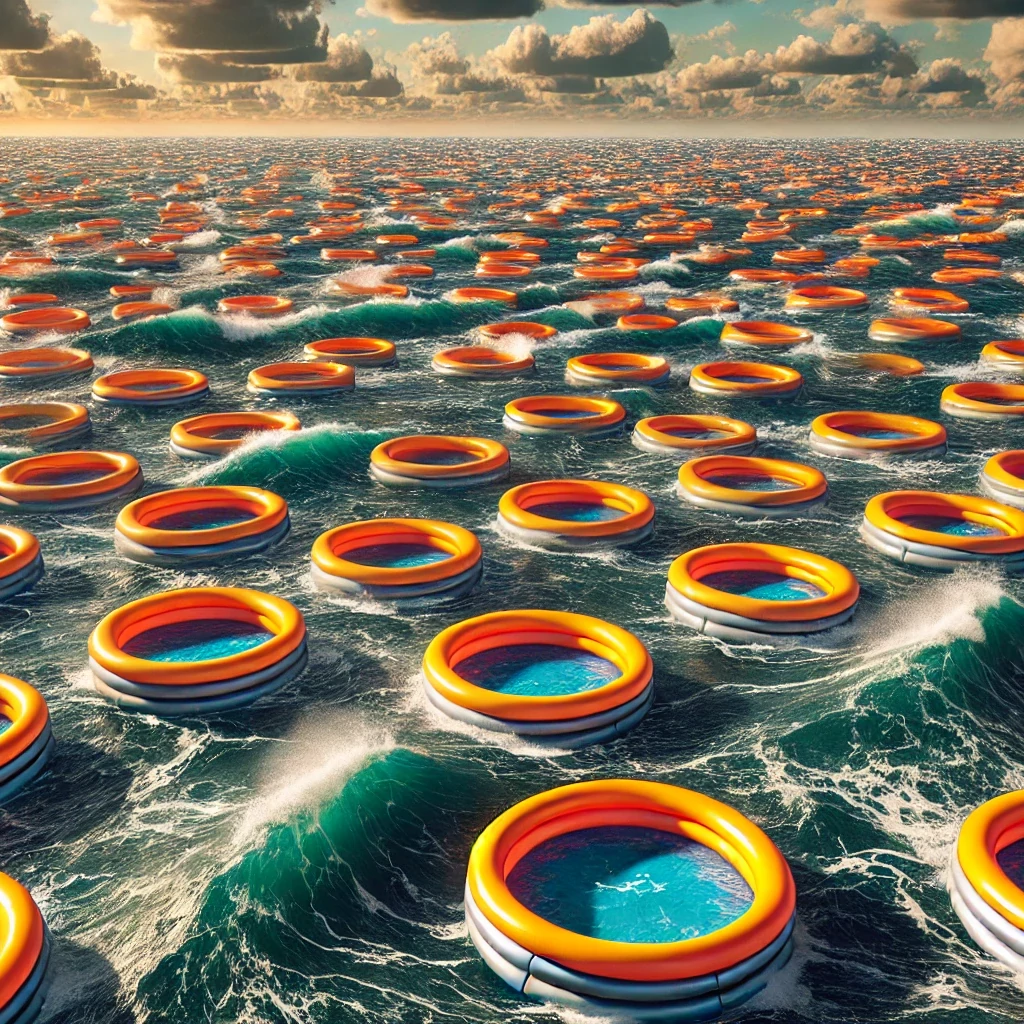
Forget clunky, land-hogging solar panels. The Tabbre Project's vision of clean energy abundance rests on something far more elegant and ingenious: floating solar rafts. These aren't just rafts with solar panels slapped on top; they're self-contained, mini power stations, designed from the ground up for the unique challenges and opportunities of the open ocean. Imagine a vast, shimmering armada, silently and efficiently converting sunlight into the fuel of the future.
Picture a circular raft, about five metres across, gently bobbing on the calm waters of an oceanic gyre. It looks deceptively simple, almost like a giant, high-tech inflatable lilo. But beneath the surface (and even on the surface), there's some seriously clever engineering going on.
The raft's surface is covered not with traditional silicon solar panels, but with a revolutionary material: perovskite. Perovskite photovoltaics (PVs) are the rock stars of the solar world right now. They're cheaper to produce than silicon, potentially more efficient, and crucially, they can be made into thin, flexible films. This means we can ditch the rigid glass and create solar cells that can be applied to almost any surface – in this case, a durable, recyclable plastic that forms the base of the raft.
But here's where it gets really interesting. The Tabbre rafts don't just generate electricity; they use that electricity to produce hydrogen directly on board. Each raft has a small, highly efficient electrolyser unit tucked away beneath the surface. This unit takes in desalinated seawater and, using the electricity from the perovskite PVs, splits it into its component parts: hydrogen and oxygen. The oxygen is harmlessly released, and the hydrogen? That's where the magic happens.

Instead of relying on bulky, expensive storage tanks, the Tabbre rafts use their own inflatable structure to store the hydrogen. As the electrolyser does its work, the hydrogen gas is pumped into the raft's circular rim, gradually inflating it like a balloon. This provides both buoyancy and a built-in, scalable storage solution. It's elegant, efficient, and eliminates the need for separate storage infrastructure.
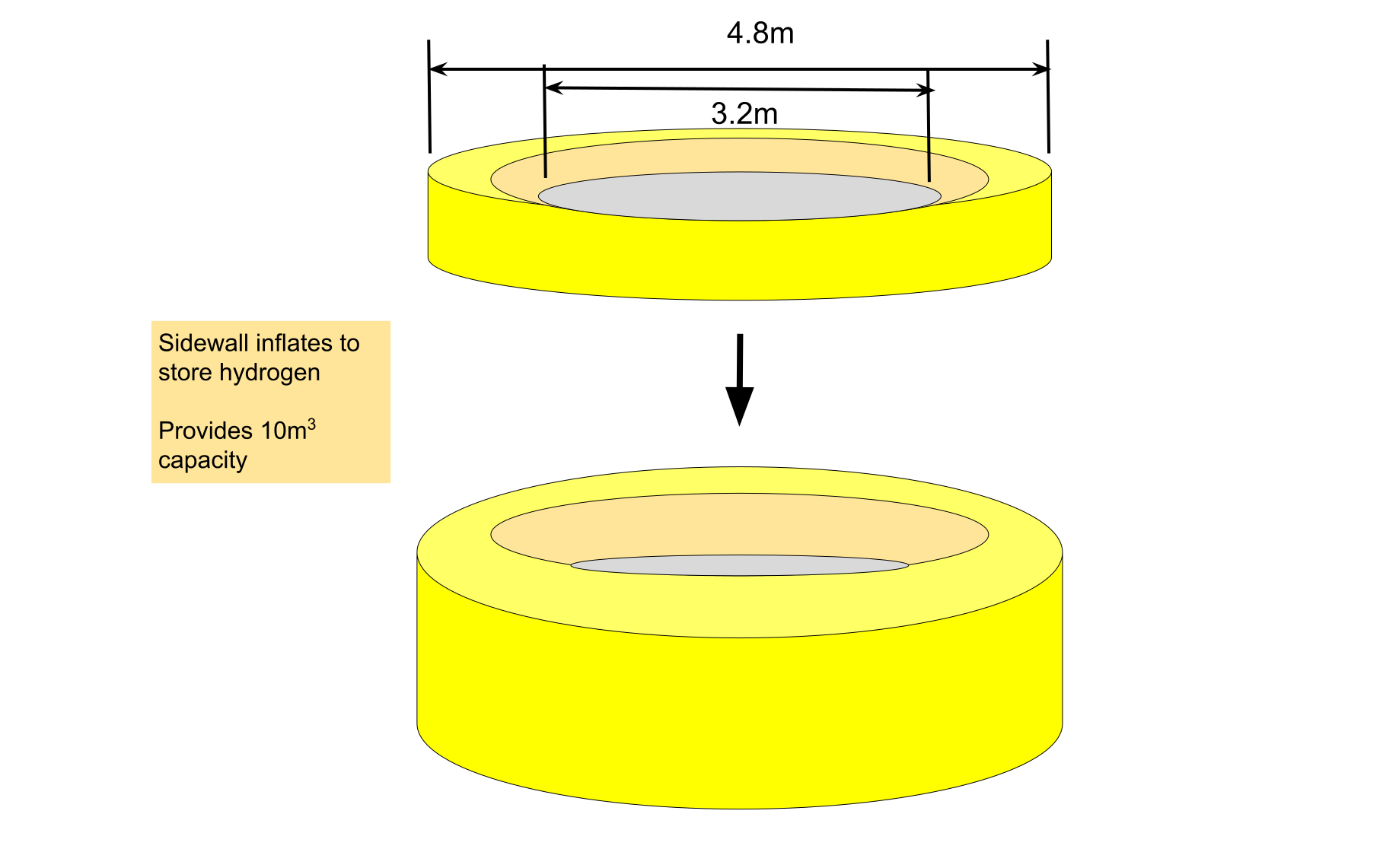
And there's more. The rafts are designed to operate partially submerged. A thin layer of seawater constantly flows over the perovskite PV surface. This does two crucial things: it keeps the PV cells cool, boosting their efficiency and lifespan (perovskites, like most electronics, perform better at lower temperatures), and it keeps them clean, washing away dust, salt, and any other debris that might block the sunlight.
This ingenious design tackles the biggest problem facing solar energy: intermittency. The sun doesn't shine 24/7, but by converting sunlight into hydrogen, a storable fuel, the Tabbre rafts effectively turn solar power into a continuous, on-demand energy source. The hydrogen can be collected and used whenever and wherever it's needed, powering everything from homes and businesses to ships and aeroplanes.
These rafts aren't designed to be permanent fixtures. They have a target lifespan of about ten years, after which they'll be collected, recycled, and replaced with new, upgraded models. The entire system is designed with sustainability in mind, using recyclable materials and minimizing waste.
The Tabbre solar rafts are more than just pieces of technology; they're the building blocks of a new energy future. They're a testament to human ingenuity, a demonstration that we can harness the power of nature in a way that's both effective and environmentally responsible. They are, quite literally, floating solar empires, poised to transform the way we power the world.
Chapter 6: Robots, Refineries, and Renewable Fuel: The Automated Energy Supply Chain
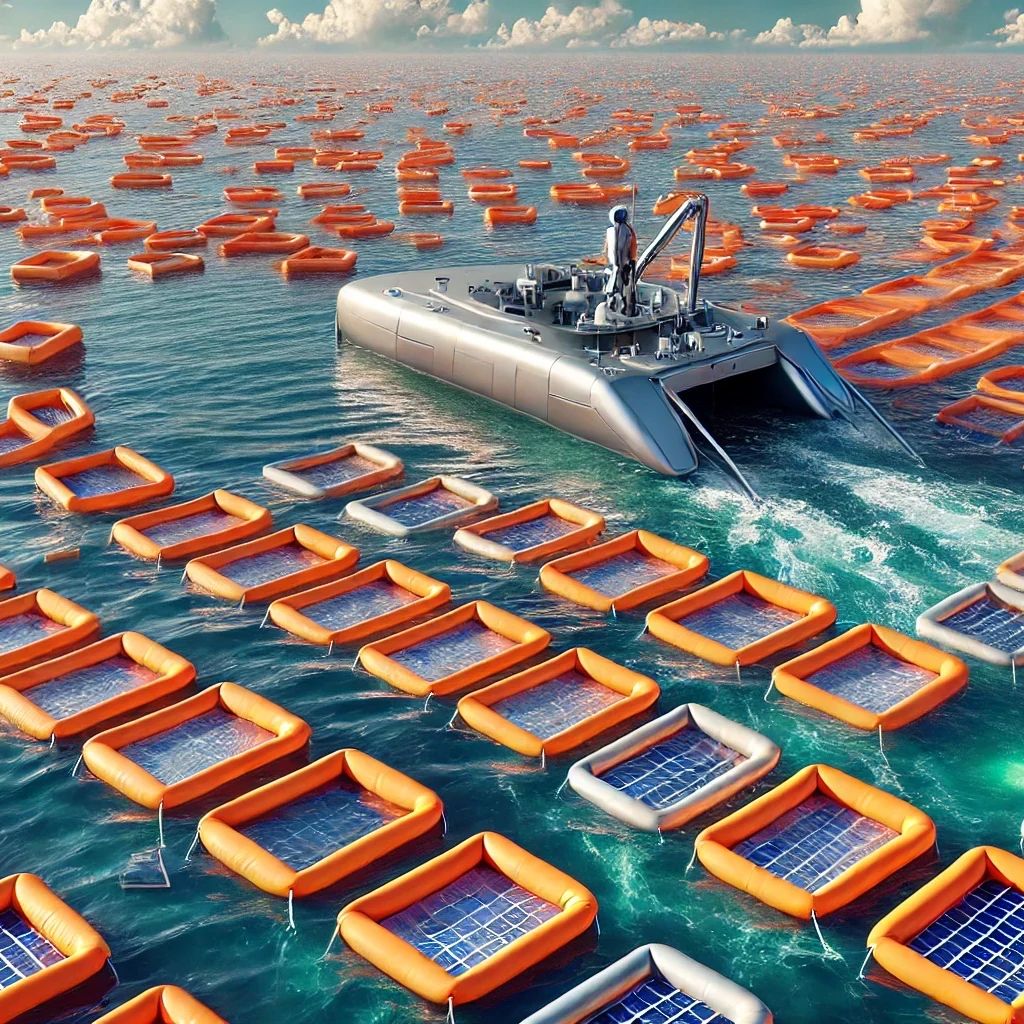
The Tabbre solar rafts are the silent workhorses of this new energy revolution, but they're just the first step. Once they've captured the sun's energy and converted it into hydrogen, a sophisticated, fully automated system takes over, transforming that raw fuel into readily usable forms and delivering it to the world. Think of it as a robotic ballet on the high seas, orchestrated by artificial intelligence.
Our story begins with RV Intrepid, a sleek, autonomous vessel gliding silently through the calm waters of the South Atlantic gyre. Intrepid isn't your average ship. It's a harvester, a robotic wrangler designed specifically for the Tabbre Project. Its hull is a SWATH design – Small Waterplane Area Twin Hull – meaning most of its bulk is submerged, connected to the deck by narrow struts. This gives it incredible stability, even in choppy seas, essential for the delicate task of retrieving solar rafts.
Intrepid is on a mission. Its AI-powered navigation system, guided by GPS and a constant stream of data from satellites and onboard sensors, has identified a cluster of solar rafts ready for harvesting. These rafts, their inflatable rims plump with stored hydrogen, have been diligently working for days, soaking up the sun's energy.
As Intrepid approaches a raft, its robotic arms spring to life. Guided by machine vision – sophisticated cameras and algorithms that can "see" and interpret the world – the arms extend and gently grasp the raft's retrieval pole. With a smooth, precise motion, the raft is lifted from the water and onto Intrepid's deck.
Inside the harvester, another set of robots takes over. The hydrogen is extracted from the raft's inflatable storage and compressed into standardized containers. The raft's supply of desalinated water is replenished, ready for another cycle of electrolysis. The raft itself is inspected for any signs of wear and tear, a quick diagnostic check to ensure it's in top condition. All of this happens without a single human hand involved.
Intrepid continues its rounds, collecting hydrogen from raft after raft, its storage containers filling up with the clean fuel. Once full, it sets course for its next rendezvous: FS Phoenix, a floating factory platform

FS Phoenix is a different beast altogether. It's a massive, mobile refinery, a chemical plant at sea. As Intrepid docks, robotic cranes swing into action, unloading the containers of compressed hydrogen and replacing them with empty ones. The hydrogen is then piped to the heart of the platform, where the real transformation begins.
Here, the Tabbre Project utilizes two well-established chemical processes, but with a renewable twist. Some of the hydrogen is used to create ammonia (NH₃), a crucial ingredient in fertilizers and a potential fuel for ships and power plants. This is done through the Haber-Bosch process – a century-old method of combining nitrogen from the air with hydrogen under high pressure and temperature. It's a tried-and-tested technology, but Tabbre makes it sustainable by powering it entirely with renewable energy.
The rest of the hydrogen is used to create methane (CH₄), or synthetic natural gas. This is achieved through the Sabatier reaction, which combines hydrogen with carbon dioxide. But here's the crucial part: the CO₂ isn't sourced from fossil fuels; it's captured directly from the atmosphere or extracted from seawater, making the resulting methane carbon-neutral. It's like turning a greenhouse gas into a clean fuel – a chemical alchemy that helps close the carbon loop.
The ammonia and methane are then liquefied, making them easier to store and transport. Specialized tanker ships, themselves potentially powered by Tabbre's fuels, dock with FS Phoenix, load up the liquefied gases, and set sail for ports around the world, delivering clean energy to homes, businesses, and industries.
The entire process, from the solar rafts to the factory platforms to the delivery ships, is overseen by a sophisticated network of AI. Algorithms optimize the harvesters' routes, manage the chemical reactions on the factory platforms, predict maintenance needs, and ensure the smooth, efficient flow of energy from the ocean to the consumer. It's a symphony of automation, a testament to human ingenuity and our ability to harness technology for the greater good.
This isn't just about building machines; it's about building a system – a self-regulating, sustainable energy supply chain that can power the world without costing the Earth. It's a vision of a future where clean energy is abundant, affordable, and accessible to all, a future where robots and AI work in harmony with nature to create a brighter tomorrow.
Chapter 7: Closing the Loop: Sustainability Beyond Clean Energy
The Tabbre Project isn't just about generating clean energy; it's about building a truly sustainable system – one that minimizes its environmental footprint, maximizes resource utilization, and potentially even helps to heal the planet. It's about closing the loop, embracing circular economy principles, and going beyond simply doing less harm to doing positive good.
Think of it as a giant, oceanic recycling programme, powered by the sun.
The solar rafts, the very foundation of the Tabbre system, are designed with sustainability in mind. They're made primarily from durable, recyclable plastic – the same kind of stuff used in food packaging, but engineered to withstand the harsh marine environment. And when these rafts reach the end of their useful life (around ten years), they won't end up as ocean pollution. They'll be collected by the harvester vessels, brought back to specialized recycling facilities (likely integrated into the factory platforms or located on land), and broken down into their constituent materials.
These materials – the plastic, the metals from the electrolysers, even the components of the perovskite PV cells – will then be reused to manufacture new rafts, closing the loop and minimizing the need for virgin resources. It's a circular economy in action, powered by renewable energy and orchestrated by robots.
But Tabbre's commitment to sustainability goes even further. The project also has the potential to contribute to ocean cleansing. The harvester vessels, as they crisscross the gyres, could be equipped with specialized nets or filters to collect plastic debris and other pollutants from the ocean surface. The gyres, unfortunately, have become notorious for accumulating vast amounts of plastic waste – the so-called "garbage patches." Tabbre could turn this problem into an opportunity, using its infrastructure to help clean up the mess we've made. The plastic collected will be recycled.
And then there's the intriguing concept of albedo. Albedo is simply a measure of how much sunlight a surface reflects. Light-coloured surfaces, like snow and ice, have a high albedo, reflecting most of the sun's energy back into space. Dark surfaces, like the open ocean, have a low albedo, absorbing most of the energy.
The Tabbre solar rafts, even though partially submerged, will likely have a higher albedo than the surrounding ocean water. By covering a significant area of the gyres with these more reflective surfaces, Tabbre could potentially have a slight cooling effect on the planet, partially offsetting global warming. It's like creating a giant, floating sunshade. The exact magnitude of this effect is still being researched, and the project will initially aim for a neutral albedo, but it's a fascinating example of how Tabbre could not only provide clean energy but also actively contribute to climate regulation. However it should be noted that Tabbre's plan for global cooling is achieved by replacing fossil fuels, with zero emmission fuels.
The Tabbre Project is demonstrating that it is creating a system that is circular by design. The project recognizes that true sustainability isn't just about reducing our negative impact; it's about creating a positive impact – restoring ecosystems, cleaning up pollution, and actively contributing to the health of the planet. It's about building a future where economic progress and environmental stewardship go hand in hand, where we can power our world without destroying it. It's a vision of abundance, not just of energy, but of a healthy, thriving planet for generations to come.
Part 3: The Tabbre Ecosystem – Powering a New Economy
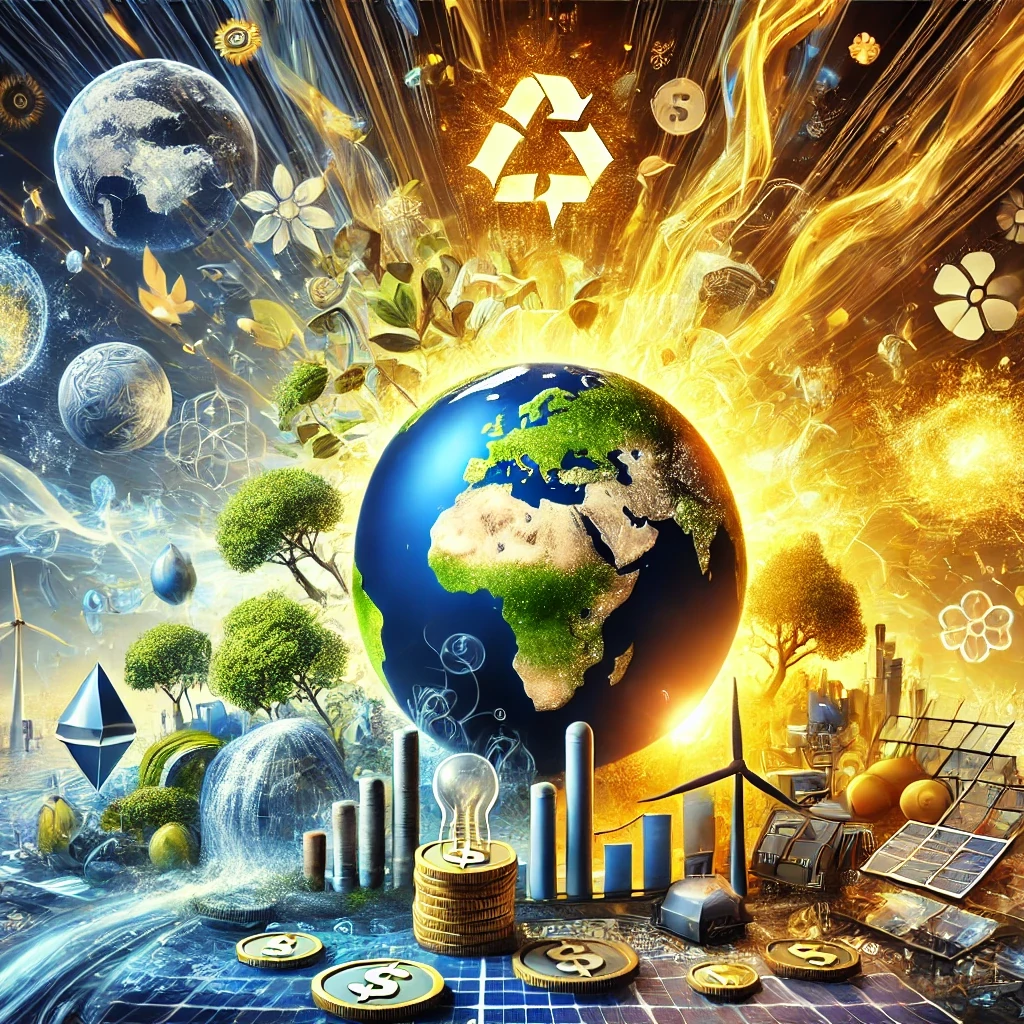
Chapter 8: Beyond Bitcoin: A Cryptocurrency with a Purpose
You've probably heard of Bitcoin, Ethereum, and the whole cryptocurrency craze. Maybe you've dabbled in it, maybe you're a seasoned crypto veteran, or maybe you're just plain baffled. Whatever your level of experience, forget everything you think you know about digital currencies for a moment. The Tabbre Project isn't just about creating another speculative asset; it's about using blockchain technology to build a fundamentally different kind of financial system – one that's intertwined with clean energy and social good.
First, let's demystify the jargon. A blockchain is essentially a digital ledger, a shared, secure, and transparent record of transactions. Imagine a giant spreadsheet that's duplicated across thousands of computers worldwide. Every time a transaction occurs, it's added to this spreadsheet as a "block," and that block is linked to the previous block, forming a "chain." This makes it incredibly difficult to tamper with the data, as any changes would have to be made on every copy of the spreadsheet simultaneously.
Cryptocurrencies are digital or virtual currencies that use cryptography for security and operate on a blockchain. Bitcoin, the first and most famous cryptocurrency, was designed as a decentralized alternative to traditional currencies, controlled by no single entity like a bank or government.
But here's the problem: many cryptocurrencies, including Bitcoin, have become largely speculative assets, driven by hype and market sentiment rather than real-world utility. Their value fluctuates wildly, and their energy consumption (particularly for "proof-of-work" blockchains like Bitcoin) is often astronomical, ironically contributing to the very climate crisis they sometimes claim to solve.
The Tabbre Project takes a different approach. It's not about creating another get-rich-quick scheme; it's about using blockchain technology to power a real-world ecosystem – the ecosystem of clean energy production, distribution, and consumption. And it does this through two purpose-built cryptocurrencies: TABB and BRE.
Think of TABB and BRE as two sides of the same coin (pun intended).
TABB (Token for Administering the BRE Blockchain): This is the "governance" token. It's like owning shares in the Tabbre Project. Holders of TABB have a say in how the project is run, voting on key decisions and influencing its future direction. But it's also an investment token. The Tabbre Project is designed to generate significant profits from the sale of its clean energy, and a portion of those profits will be used to buy back and burn TABB tokens, reducing the supply and potentially driving up the value for remaining holders. It's a deflationary model, designed to reward long-term commitment.
BRE (Basic Renewable Energy): This is the "utility" token. It's a stablecoin, meaning its value is pegged to something real – in this case, the price of energy produced by the Tabbre Project. This makes it ideal for everyday transactions, unlike the volatile price swings of many other cryptocurrencies. BRE is what you'll use to buy energy from Tabbre, and it's also what will be used to pay out the Global Universal Basic Income (GUBI) – a revolutionary concept we'll explore in later chapters.
So, why two tokens? Because they serve different, but complementary, purposes. TABB provides a way to invest in the project's long-term success and participate in its governance, while BRE provides a stable, reliable medium of exchange for the energy economy. It's a two-pronged approach, designed to create a self-sustaining, equitable, and decentralized financial ecosystem.
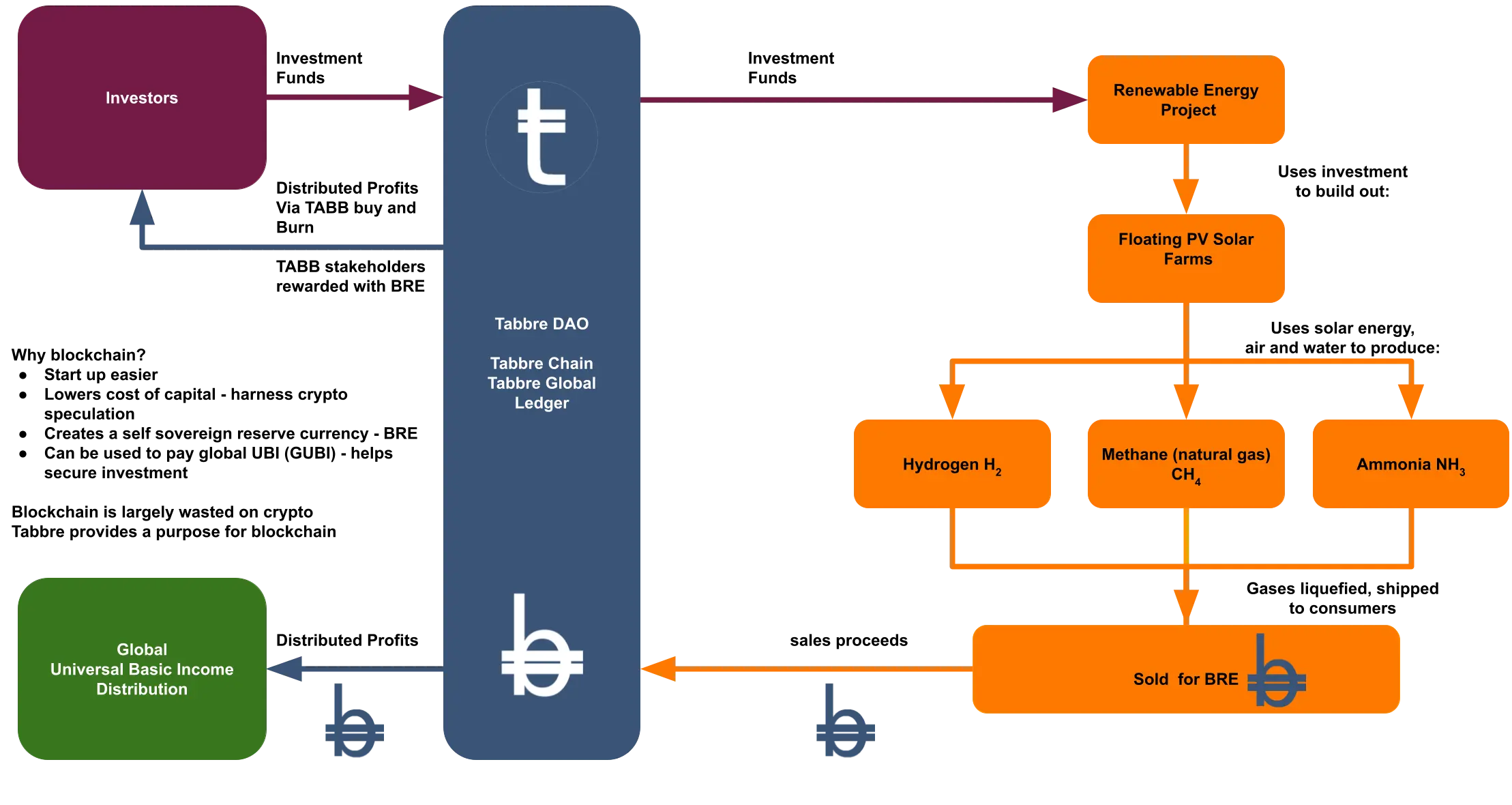
The Tabbre Project is demonstrating that cryptocurrency can be more than just a speculative tool. It can be a powerful force for good, a way to incentivize clean energy production, promote financial inclusion, and build a more sustainable and equitable future. It's a vision of a world where finance and technology work together to solve some of humanity's greatest challenges.
Chapter 9: TABB: Investing in the Future – More Than Just a Token
TABB isn't your typical cryptocurrency. It's not just another volatile asset to trade on exchanges; it's a stake in the future of clean energy, a key to participating in a revolutionary project, and a potential pathway to significant financial returns. Think of it as owning shares in a company that's building a global, decentralized power grid – but with a twist.
As we introduced in the previous chapter, TABB is the governance and investment token of the Tabbre ecosystem. This means it serves two crucial, intertwined functions:
1. Governance: Shaping the Future of Tabbre
The Tabbre Project isn't controlled by a CEO or a board of directors in some distant office tower. It's governed by a Decentralized Autonomous Organization (DAO), a community of TABB holders who have a direct say in how the project is run. It's like a digital democracy, powered by the blockchain.
Holding TABB tokens gives you voting rights within the DAO. The more TABB you hold, the more weight your vote carries. This allows you to participate in key decisions, such as:
Approving new developments: Should Tabbre expand into a new oceanic gyre? Should it invest in researching a new type of solar cell? TABB holders get to vote on these kinds of strategic choices.
Allocating resources: How should the Tabbre Foundation's treasury be spent? Should more funds go towards research and development, marketing, or community initiatives? TABB holders have a say.
Modifying the rules: Even the rules governing the Tabbre ecosystem itself can be changed through DAO proposals and votes, ensuring that the project remains adaptable and responsive to the needs of its community.
This isn't just about abstract governance; it's about giving you, the investor and stakeholder, a real voice in shaping the future of the project. It's about ensuring that Tabbre remains aligned with its core values of sustainability, equity, and decentralization.
2. Investment: Riding the Wave of Abundance
TABB is also designed as an investment token, with a built-in mechanism to potentially drive significant value appreciation over time: the buyback and burn programme.
Here's how it works:
Profits from Energy Sales: As the Tabbre Project generates revenue from selling its clean energy (priced in BRE), a portion of those profits will be used to buy back TABB tokens from the open market.
Burning the Tokens: These repurchased TABB tokens won't be held by the project; they'll be burned – permanently removed from circulation by sending them to an unrecoverable address. This is like a company buying back its own shares and then tearing them up.
Reducing Supply, Increasing Scarcity: By reducing the total supply of TABB, the buyback and burn mechanism creates scarcity. And as any economics textbook will tell you, scarcity, combined with demand, tends to drive up value.
The beauty of this system is that it directly links the value of TABB to the success of the Tabbre Project. The more energy Tabbre produces and sells, the more profits it generates, the more TABB it can buy back and burn, and (potentially) the higher the value of the remaining TABB tokens. It's a virtuous cycle, designed to reward long-term holders and align their interests with the project's overall goals. And all of this is achieved with no new minting of TABB.
This is all part of the project's plan to deliver Super Abundance.
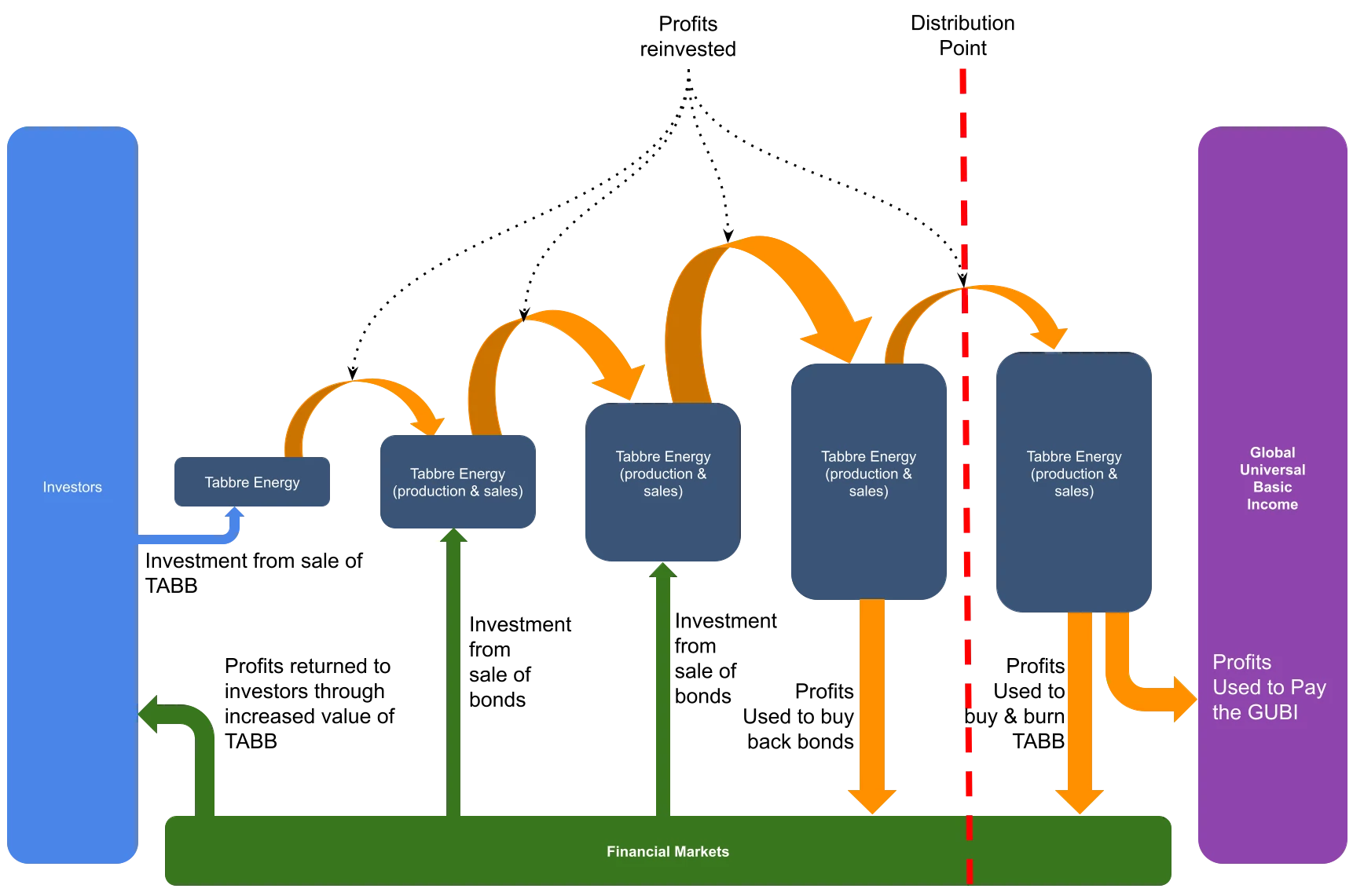
It's important to be realistic, of course. Investing in any cryptocurrency involves risk, and TABB is no exception. Market conditions can fluctuate, and there's no guarantee of specific returns. But the Tabbre Project's unique combination of a real-world utility (clean energy), a deflationary token model, and a decentralized governance structure makes TABB a compelling proposition for investors who believe in the future of sustainable energy and decentralized finance.
By holding TABB, you're not just buying a token; you're buying into a vision – a vision of a world powered by clean, abundant energy, where financial systems are more equitable, and where everyone has the opportunity to thrive. You're becoming part of a movement, a community of individuals who are committed to building a better future.
Chapter 10: BRE: The Currency of Clean Energy – Powering Transactions, Empowering People
While TABB represents an investment in the future of the Tabbre Project, BRE (Basic Renewable Energy) is the currency of its present. It's the lifeblood of the ecosystem, the medium of exchange that will power transactions, fund a global basic income, and potentially, revolutionize the way we think about money. Think of it as the watt-hour made digital.
Unlike the wild price swings of many cryptocurrencies, BRE is designed to be a stablecoin. But it's not pegged to a volatile fiat currency like the US dollar. Instead, its value is tied to something far more fundamental: energy. Specifically, the price of energy produced by the Tabbre Project's floating solar farms.
This is a game-changer.
Imagine buying your electricity bill, not in pounds or euros, but in BRE. Imagine businesses trading goods and services, priced in BRE. Imagine receiving a universal basic income, paid in BRE. This is the vision of the Tabbre ecosystem – a world where energy and currency are seamlessly intertwined.
Why is this so important? Because it creates a direct link between the real economy (the production and consumption of energy) and the financial system. It grounds the value of BRE in something tangible, something essential to human life. It's not based on speculation or hype; it's based on the fundamental need for power.
Here's how it works:
Energy Production: The Tabbre solar farms generate clean, renewable energy.
Pricing in BRE: That energy is priced and sold in BRE. This creates inherent demand for the token – if you want to buy Tabbre's energy, you need BRE.
Stable Value: The price of BRE is designed to remain relatively stable, reflecting the price of energy. This is crucial for its use as a medium of exchange. Nobody wants to use a currency that could be worth half as much tomorrow.
Global Reach: BRE isn't tied to any particular country or government. It's a global currency, accessible to anyone with an internet connection.
But how does Tabbre maintain that stable value? That's where the algorithmic stability mechanism comes in. It's a bit like a self-regulating thermostat for the currency.
At the heart of this mechanism is the BRE Monetary Authority (BMA) – a Decentralized Autonomous Organization (DAO) governed by TABB holders. Think of it as a kind of "decentralized central bank" for BRE. The BMA's job is to keep the price of BRE stable, and it does this by adjusting the supply of the token in response to market demand.
If the price of BRE starts to rise above its target price (meaning there's too much demand relative to supply), the BMA can create and issue new BRE, increasing the supply and (ideally) bringing the price back down.
If the price of BRE starts to fall below its target price (meaning there's too little demand relative to supply), the BMA can buy back BRE from the open market, decreasing the supply and (ideally) pushing the price back up.
This is all done through smart contracts – self-executing agreements written in code – ensuring transparency and preventing manipulation. The rules governing the BMA are clear, and TABB holders can vote to change them if needed.
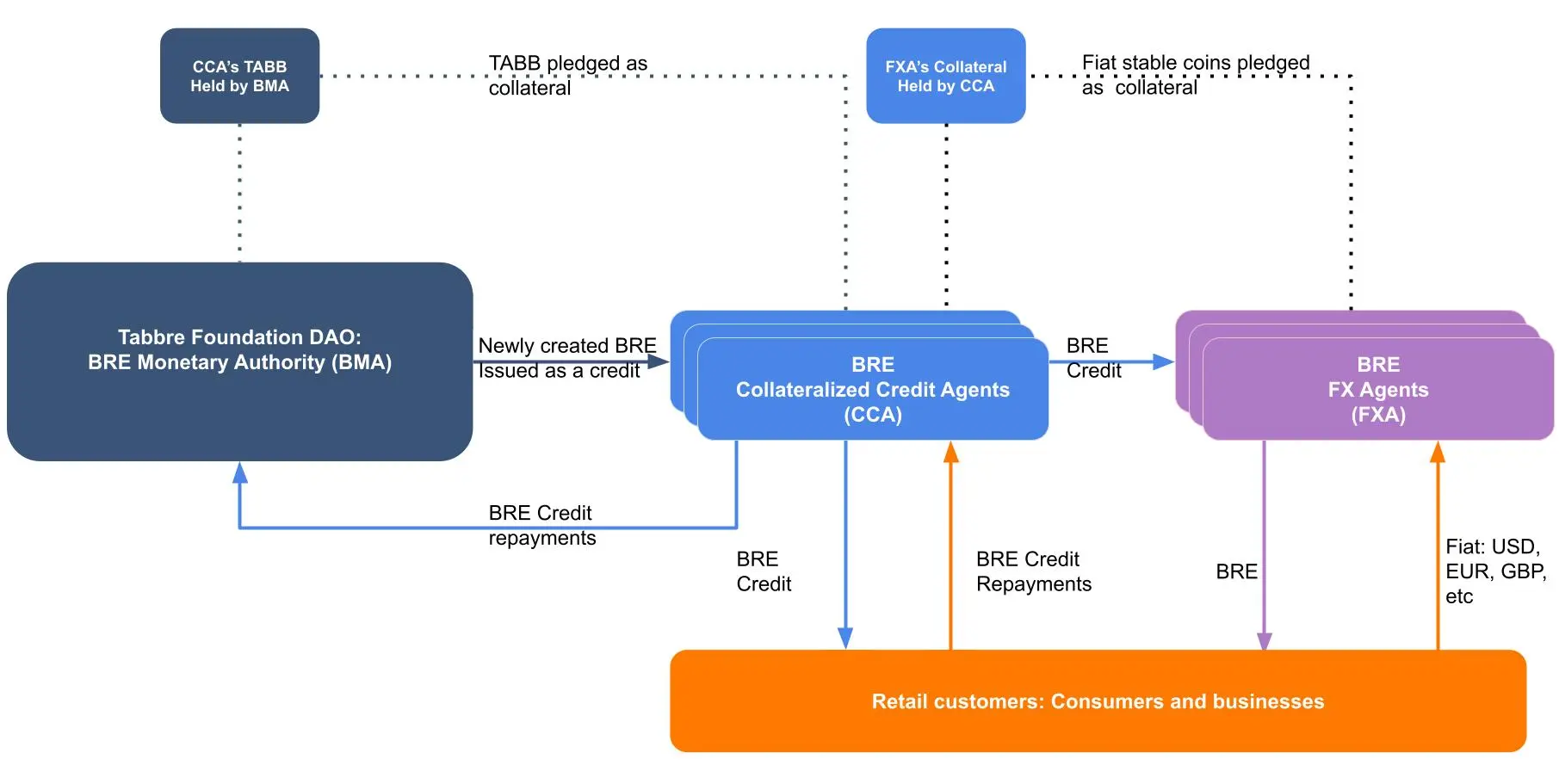
New BRE is created as credit. The BMA will lend newly created BRE to Collateralized Credit Agents. These, in turn, will lend to consumers and businesses.
But BRE is more than just a stable medium of exchange. It's also the key to unlocking one of the Tabbre Project's most ambitious goals: a Global Universal Basic Income (GUBI). By distributing a portion of the project's profits in BRE to people worldwide, Tabbre aims to create a financial safety net, empower individuals, and promote economic equality.
And, because of its global use and backing by energy. BRE has the potential to become a self-sovereign global currency. Free from the control of central banks and national governments.
The Tabbre Project, with its innovative use of BRE, aims to offer solutions for some of the failures of the global financial system.
In essence, BRE is the currency of a new energy economy – a cleaner, fairer, and more sustainable economy, powered by the sun and secured by the blockchain. It's a bold vision, but one that's grounded in sound economic principles and a deep commitment to social good.
Chapter 11: A Universal Basic Income: Funding a Fairer Future – From Energy Abundance to Economic Empowerment

The Tabbre Project isn't just about clean energy; it's about building a more equitable world. And that's where one of its most radical ideas comes in: a Global Universal Basic Income (GUBI), funded by the profits from its solar energy production and paid in its own cryptocurrency, BRE.
Imagine a world where everyone, regardless of their background, location, or employment status, receives a regular, unconditional payment – enough to cover their basic needs, enough to provide a foundation of financial security. That's the promise of a UBI.
It's a concept that's been debated for decades, gaining traction in recent years as a potential solution to poverty, inequality, and the economic disruptions caused by automation and climate change. But the Tabbre Project offers a unique twist: it provides a sustainable, decentralized funding mechanism for a UBI, tied directly to the production of clean energy.
Here's how it works:
Profit Generation: As Tabbre's floating solar farms generate and sell clean energy, they generate significant profits.
GUBI Allocation: A substantial portion of these profits will be allocated to the GUBI fund. This isn't a charitable donation; it's a core principle of the Tabbre ecosystem, hardwired into its economic model.
Distribution in BRE: The GUBI will be paid out in BRE, the Tabbre stablecoin pegged to the price of energy. This ensures that the payments have real-world value and can be used to purchase essential goods and services, including, of course, energy itself.
Global Reach: The GUBI is intended to be global, reaching individuals in every corner of the world, regardless of their nationality or citizenship. The Tabbre Project envisions a future where everyone has access to a basic level of economic security.
Decentralized Distribution: The distribution mechanism will leverage blockchain technology to ensure transparency, efficiency, and security, minimizing the risk of corruption or mismanagement.
The potential impact of a GUBI, funded by clean energy profits, is enormous:
Poverty Reduction: A GUBI could lift millions, perhaps even billions, of people out of poverty, providing them with the resources to meet their basic needs and improve their living standards.
Economic Empowerment: With a basic income floor, individuals would have greater freedom to pursue education, entrepreneurship, or creative endeavors, without the constant pressure of survival.
Increased Economic Activity: The GUBI could stimulate local economies by increasing purchasing power and demand for goods and services.
Improved Health and Well-being: Studies have shown that basic income programs can lead to improvements in physical and mental health, reduced stress, and increased social cohesion.
Greater Resilience to Shocks: A GUBI could provide a crucial safety net during economic downturns, natural disasters, or other crises, helping individuals and communities to weather difficult times.
Imagine Fatima, a single mother in a rural village in Kenya. She struggles to feed her children and keep a roof over their heads. With a GUBI, she could afford nutritious food, send her children to school, and perhaps even start a small business, selling vegetables at the local market.
Or consider Mateo, a young artist in Brazil, who dreams of pursuing his passion but is forced to work long hours at a dead-end job just to make ends meet. With a GUBI, he could dedicate more time to his art, develop his skills, and contribute his creativity to the world.
These are just two examples, but they illustrate the transformative potential of a GUBI. It's not about handouts; it's about empowerment. It's about giving people the breathing room to pursue their dreams, contribute to their communities, and build a better future for themselves and their families.
Of course, a GUBI is not a magic bullet, and there are legitimate questions and concerns that need to be addressed:
Feasibility: Can the Tabbre Project generate enough profit to fund a meaningful GUBI on a global scale? The project's ambitious production targets and low operating costs suggest that it's possible, but it will require significant time and investment to reach that level.
Impact on Work Ethic: Will a GUBI disincentivize work? Studies on existing basic income pilot programs suggest that the impact on overall employment is minimal, and in some cases, it can even increase entrepreneurship and participation in education or volunteer work.
Inflation: Could a large-scale GUBI lead to inflation? The Tabbre Project's use of BRE, a stablecoin pegged to energy prices, is designed to mitigate this risk. Furthermore, the increased economic activity spurred by the GUBI could lead to increased production of goods and services, further counteracting inflationary pressures.
Distribution Challenges: How do you ensure that a GUBI reaches everyone, including those in remote areas or without access to technology? This will require innovative solutions, potentially involving mobile technology, decentralized identity systems, and partnerships with local organizations.
The Tabbre Project is committed to addressing these challenges head-on, through careful planning, ongoing research, and collaboration with experts in the field. The GUBI is a bold experiment, but one that's worth pursuing. It's a vision of a future where everyone has a share in the abundance created by clean energy, a future where economic security is a fundamental human right.
Chapter 12: Decentralizing Power, Empowering People: A New Financial Order
The Tabbre Project's vision extends beyond clean energy and a universal basic income. It aims to fundamentally reshape the global financial landscape by creating a self-sovereign global currency – BRE – that is independent of national governments and central banks. This isn't just about creating a new way to pay for electricity; it's about building a more just, equitable, and resilient financial system for the 21st century.
For centuries, the global economy has been dominated by fiat currencies – currencies issued and controlled by national governments. The US dollar, the Euro, the Yen – these currencies are powerful tools, but they're also subject to the political and economic whims of their respective nations. Monetary policy, interest rates, and exchange rates are often determined by national interests, which may not always align with the needs of the global community.
This can lead to significant problems:
Currency Manipulation: Governments can manipulate their currencies for political or economic gain, potentially harming other countries.
Economic Instability: National economic crises can trigger currency devaluations, wiping out savings and disrupting international trade.
Financial Exclusion: Billions of people lack access to traditional banking services and are excluded from the global financial system.
Sanctions and Political Influence: National currencies can be used as tools of political influence, with sanctions and restrictions imposed on individuals, businesses, or entire countries.
Inflation: Fiat currencies can be printed at will by governments.
BRE offers a different model. It's a decentralized currency, meaning it's not controlled by any single entity. It's global, accessible to anyone with an internet connection. And it's backed by energy, a fundamental human need, giving it inherent, real-world value.
Imagine a world where:
A small business owner in Nigeria can trade directly with a customer in Argentina, without having to worry about fluctuating exchange rates or exorbitant bank fees.
A refugee fleeing conflict can receive humanitarian aid directly in BRE, bypassing corrupt officials or unstable local currencies.
A community in a remote village can access financial services, such as microloans and savings accounts, through their smartphones, even without a traditional bank account.
Countries can trade with each other without being subject to the political influence of a dominant reserve currency.
This is the potential of a self-sovereign global currency. It's about empowering individuals, promoting financial inclusion, and creating a more level playing field for global trade and commerce.
The Tabbre Project's use of a Decentralized Autonomous Organization (DAO) to govern the BRE Monetary Authority is crucial. It ensures that decisions about the currency's supply and stability are made transparently and democratically, by the community of TABB holders, rather than by a small group of central bankers. This reduces the risk of manipulation and promotes trust in the system.
Of course, transitioning to a new global currency is a monumental undertaking, fraught with challenges. There will be resistance from established financial institutions and governments who may see it as a threat to their power and control. There will be technical hurdles to overcome, and regulatory frameworks to navigate.
But the potential benefits are too significant to ignore. A self-sovereign global currency, backed by clean energy and distributed through a universal basic income, could:
Reduce global poverty and inequality.
Promote financial inclusion and empower marginalized communities.
Create a more stable and resilient global financial system.
Reduce the risk of currency manipulation and economic warfare.
Foster greater international cooperation and understanding.
The Tabbre Project isn't just building solar farms; it's building a new financial infrastructure for the 21st century – a system that is more democratic, more transparent, and more aligned with the needs of a globalized world. It's a bold vision, but one that's grounded in the belief that technology can be a powerful force for positive change, empowering individuals and communities to build a more just and equitable future.
Part 4: The Road Ahead – Challenges and Opportunities
Chapter 13: The Tabbre Roadmap: Charting a Course to Energy Abundance
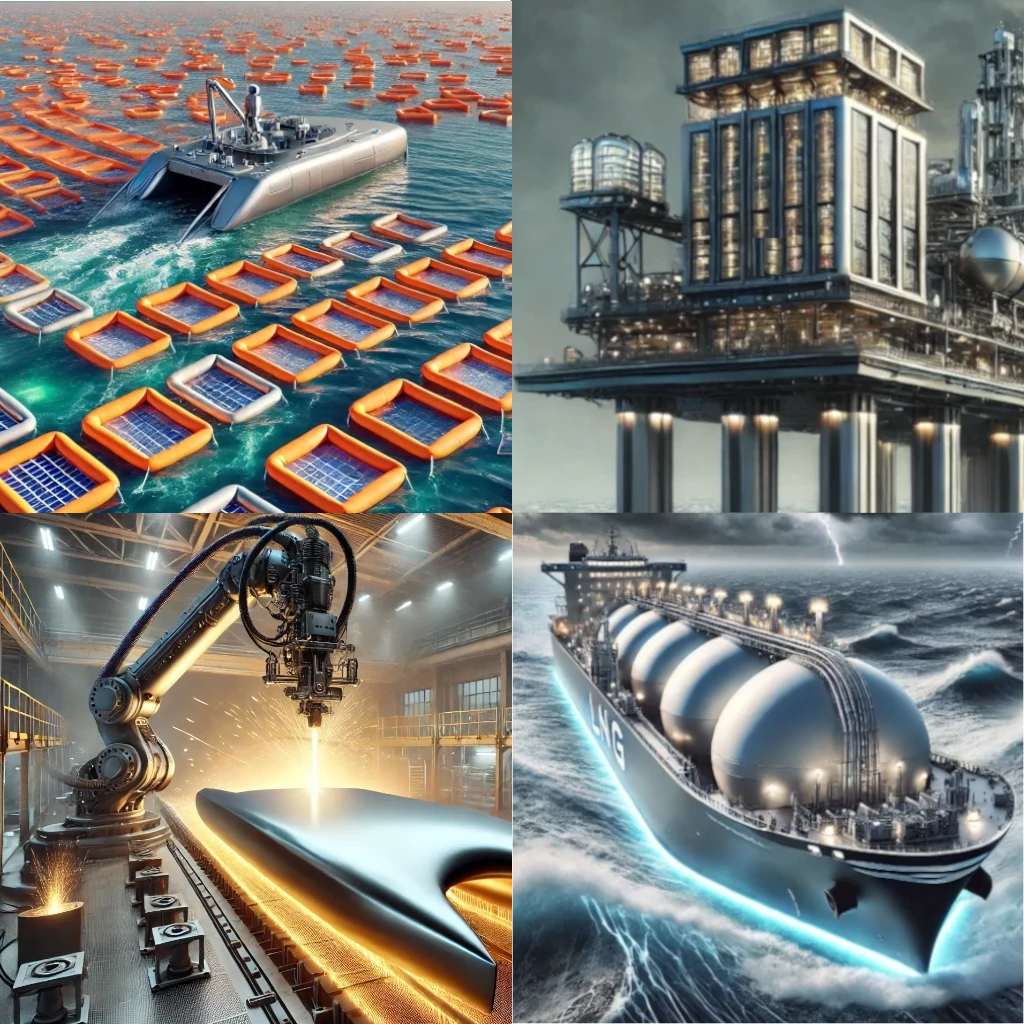
The Tabbre Project isn't a sprint; it's a marathon – a multi-decade endeavour to transform the global energy landscape. It's a journey that will require perseverance, innovation, and a relentless commitment to its vision. This roadmap outlines the key stages of that journey, from the initial concept validation to the ultimate goal of terawatt-scale clean energy production. It's a bold plan, and it won't be easy, but the potential rewards – for investors, for the planet, and for humanity – are immense.
Think of it as a series of increasingly ambitious missions, each building upon the success of the previous one.
Phase 1: Laying the Foundation (Now - 2025)
This is where we are now. It's all about proving the core concepts, building the team, and securing the initial funding. Imagine it as the "blueprint" phase, where we refine the designs, run the simulations, and convince the world that this crazy idea just might work.
Key Objectives:
Finalise the technical and economic models.
Recruit a world-class team of engineers, scientists, and business professionals.
Establish the Tabbre Foundation and the Tabbre DAO.
Secure initial seed funding through private investment.
Develop the initial version of the TabbreChain.
Begin the regulatory approval process.
Secure the first listings of TABB and BRE on cryptocurrency exchanges.
Phase 2: Proving the Concept (2025-2026)
This is where theory meets reality. We'll build a small-scale, minimum viable floating solar farm to demonstrate that the core technologies – the perovskite PV rafts, the autonomous harvesters, the on-site hydrogen production – actually work in the real world.
Key Objectives:
Build and deploy a small-scale test farm in a suitable location (likely a sheltered bay or coastal area).
Test and refine the raft design, the harvester operation, and the electrolysis process.
Gather real-world data on performance, durability, and environmental impact.
Secure Series A funding to scale up production.
Phase 3: Early Commercialisation (2027-2028)
This is where things start to get exciting. We'll move beyond the prototype stage and begin producing hydrogen on a commercial scale, targeting early adopters and demonstrating the economic viability of the project.
Key Objectives:
Establish the first commercial-scale floating solar farm in an oceanic gyre.
Begin selling hydrogen (priced in BRE) to industrial customers and utilities.
Establish the BRE Monetary Authority (BMA) and refine the algorithmic stability mechanism.
Secure Series B funding for gigawatt-scale deployment.
Start pilot production of ammonia
Phase 4: Gigawatt-Scale Expansion (2029-2031)
This is where Tabbre starts to make a real dent in the global energy market. We'll ramp up production to the gigawatt scale, building out larger solar farms and expanding our fleet of harvesters and factory platforms.
Key Objectives:
Reach 1 gigawatt (GW) of installed capacity (enough to power hundreds of thousands of homes).
Establish the BRE debt market, issuing bonds to finance further expansion.
Secure Series C funding for multi-gigawatt deployment.
Start pilot production of methane.
Phase 5: Multi-Gigawatt Growth (2032-2035)
This is the rapid growth phase, where Tabbre aims to become a major player in the global energy industry. We'll continue to expand production, deploying multiple gigawatt-scale solar farms and expanding into new oceanic gyres.
Key Objectives:
Reach 100 gigawatt capacity.
Become a significant supplier of clean hydrogen, ammonia, and methane to global markets.
Begin full scale methane production.
Continue to refine the technology and reduce costs.
Phase 6: Terawatt-Scale and Global Impact (2035 onwards)
This is the ultimate goal: reaching terawatt-scale energy production – enough to replace a significant portion of the world's fossil fuel consumption. This is also when the Tabbre Project's social impact initiatives, like the Global Universal Basic Income (GUBI), will be fully realized.
Key Objectives:
Reach 1 terawatt (TW) of installed capacity (1000 gigawatts) – and beyond.
Become the world's leading provider of clean, affordable energy.
Fully implement the GUBI, distributing a portion of profits in BRE to individuals worldwide.
Initiate the TABB buyback and burn program, driving value appreciation for TABB holders.
Establish BRE as a major global reserve currency.
Timeline Visual:
This is an ambitious timeline, and it's important to be realistic about the challenges. There will be technological hurdles, logistical complexities, regulatory approvals, and potential setbacks along the way. But the Tabbre Project is committed to transparency, adaptability, and a long-term vision. We believe that with the right team, the right technology, and the support of a global community, we can achieve these goals and create a truly sustainable energy future.
Chapter 14: Facing the Challenges: Navigating the Uncharted Waters
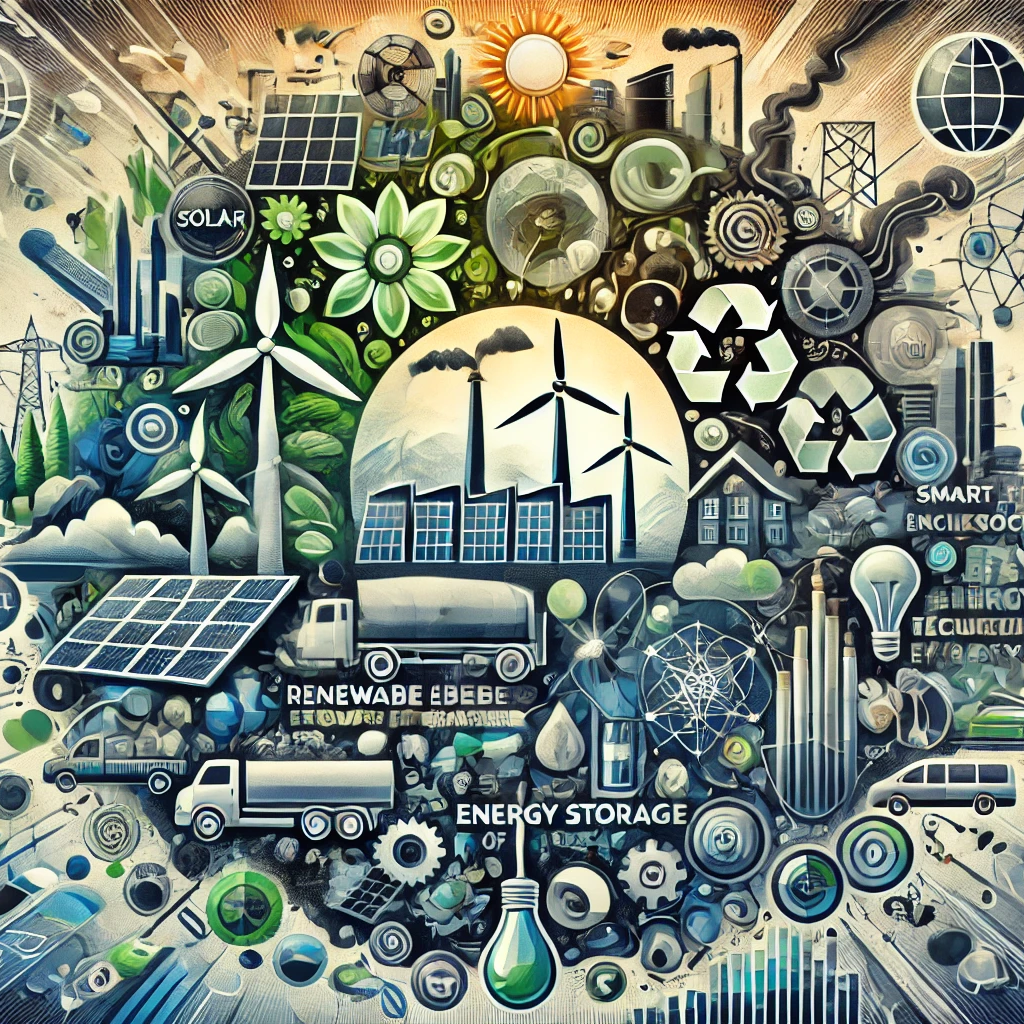
The Tabbre Project is a bold vision, a leap of faith into a future powered by clean energy and governed by decentralized principles. But it's not a fairy tale. We're not pretending this will be easy. Building a global energy infrastructure in the middle of the ocean, pioneering new technologies, and disrupting established industries comes with a significant set of challenges. We'd be doing you a disservice if we didn't acknowledge them head-on.
Think of it like launching a rocket to Mars. You need brilliant engineering, meticulous planning, and a healthy dose of courage. You also need to anticipate everything that could go wrong – and have a plan for it. That's the spirit in which we approach the challenges ahead.
Here's a glimpse of the hurdles we face, and how we plan to overcome them:
1. The Tech Gauntlet:
We're pushing the boundaries of several technologies simultaneously. Perovskite solar cells, while incredibly promising, are still relatively new, and their long-term durability in a harsh marine environment needs to be rigorously tested and proven. Autonomous navigation in the open ocean, with its unpredictable weather and potential for collisions, is a complex problem. Scaling up the production of electrolysers, and optimising the chemical processes for ammonia and methane production, will require constant innovation and refinement.
Our Approach: We're not starting from scratch. We're building upon existing technologies, but we're also investing heavily in research and development, partnering with leading universities and research institutions, and assembling a team of the brightest minds in the field. We'll use a phased approach, starting small, testing rigorously, and iterating constantly. We'll embrace failure as a learning opportunity, knowing that every setback brings us closer to a breakthrough.
2. The Financial Frontier:
Funding a project of this magnitude is a monumental task. We're talking about trillions of dollars over the long term. Securing that level of investment requires convincing investors that the Tabbre Project is not just a pipe dream, but a viable, profitable, and world-changing enterprise.
Our Approach: We'll use a multi-pronged funding strategy, combining private investment (through TABB sales), venture capital, strategic partnerships, and, eventually, debt financing (backed by our TABB holdings and future energy revenues). We'll be transparent with our progress, demonstrating tangible milestones and building trust with investors. We'll also emphasize the long-term value proposition – not just financial returns, but also the positive impact on the planet and society.
3. The Logistical Labyrinth:
Imagine managing a vast, distributed network of solar rafts, harvester vessels, and factory platforms, spread across millions of square kilometres of open ocean. It's a logistical nightmare – or, as we prefer to see it, a fascinating challenge.
Our Approach: Automation and AI are key. We'll rely on sophisticated algorithms to optimize raft placement, harvester routes, and fuel delivery. We'll use predictive maintenance to anticipate and prevent equipment failures. We'll build redundancy into the system, ensuring that the failure of any single component doesn't bring the whole operation to a halt. And we'll leverage the expertise of logistics professionals with experience in managing complex, global supply chains.
4. The Regulatory Reef:
Navigating the complex web of international maritime law, environmental regulations, and cryptocurrency regulations is a daunting task. We'll be operating in international waters, dealing with multiple jurisdictions, and pioneering a new financial model.
Our Approach: We're committed to full compliance with all applicable laws and regulations. We'll engage proactively with governments, international organizations, and regulatory bodies, working to establish clear and supportive legal frameworks for the project. We'll conduct thorough environmental impact assessments and adhere to the highest standards of environmental responsibility. We'll also have a dedicated legal team, constantly monitoring the evolving regulatory landscape.
5. The Market Minefield:
Even if we build the most amazing renewable energy system in the world, it won't matter if nobody uses it. We need to convince utilities, industries, and consumers to switch from fossil fuels to Tabbre's clean energy products. And we'll be facing competition from other renewable energy technologies, as well as potential resistance from the established fossil fuel industry.
Our Approach: Our primary weapon is price. By producing energy cheaper than fossil fuels, we'll create a powerful economic incentive for adoption. We'll also highlight the other advantages of Tabbre's energy: its reliability (thanks to hydrogen storage), its sustainability, and its positive social impact. We'll build strategic partnerships with key players in the energy industry, and we'll engage in public awareness campaigns to educate consumers about the benefits of clean energy.
6. The Geopolitical Storm. The risk of hostile governments attempting to sieze control, or interfere with, the project.
Our Approach. The project will seek acceptance by a majority of the world's governments. The payment of the GUBI will create a powerful incentive for govenments to support, rather than oppose the Tabbre Project.
We're not naive about these challenges. We know this won't be easy. But we're also confident in our ability to overcome them. We have a clear vision, a dedicated team, a robust technological foundation, and a commitment to transparency and collaboration. We believe that the Tabbre Project is not just possible; it's necessary. The future of our planet, and the well-being of billions of people, depends on bold solutions like this.
Chapter 15: A Call to Action: Be Part of the Energy Revolution
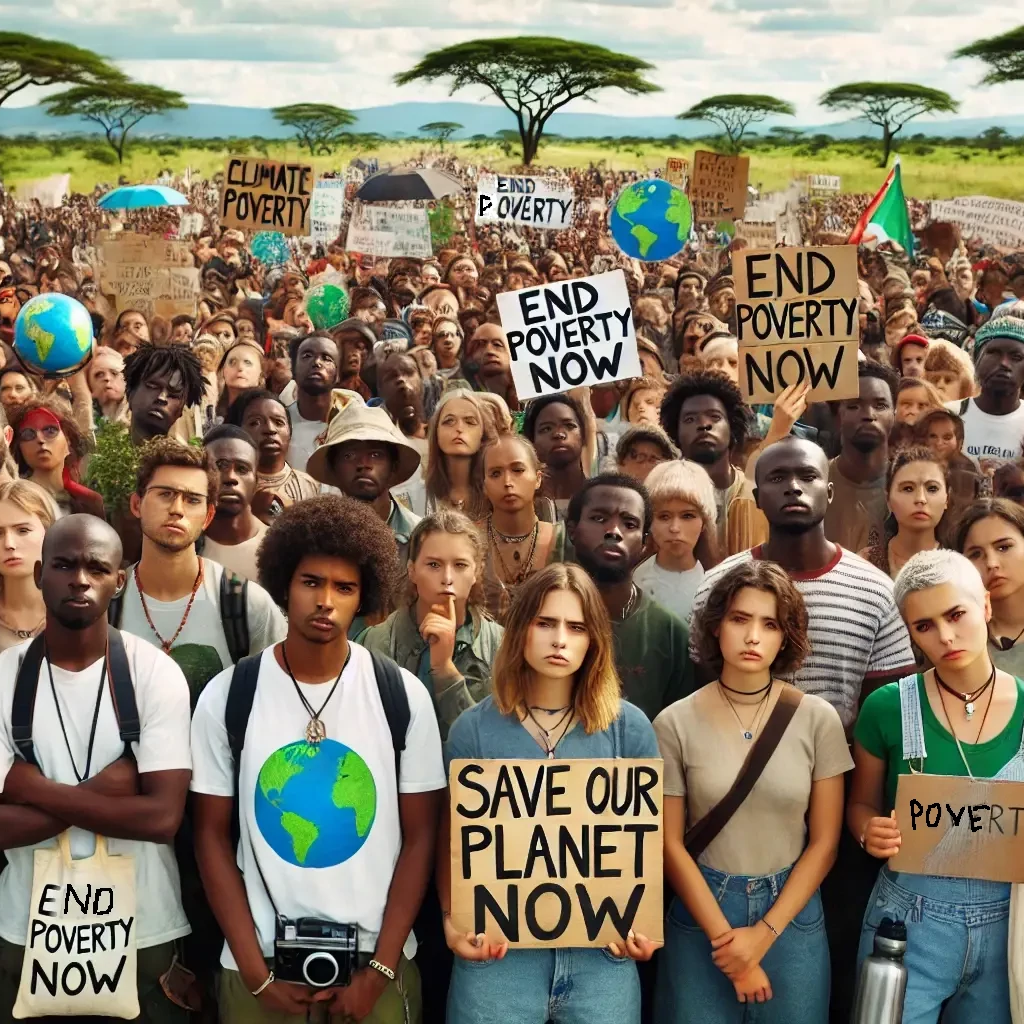
The Tabbre Project is more than just a plan on paper; it's a movement. It's a testament to human ingenuity, a bold response to the defining challenges of our time, and a vision of a future we can all be a part of.
We've journeyed from the depths of the climate crisis and the stark realities of energy poverty to the sun-drenched expanses of the oceanic gyres, where a new kind of energy revolution is taking shape. We've seen how floating solar empires, powered by cutting-edge technology and guided by artificial intelligence, can provide clean, abundant energy to the world. We've explored how a decentralized financial system, built on blockchain and fuelled by two purpose-built cryptocurrencies, can empower individuals, promote financial inclusion, and even fund a global basic income.
The Tabbre Project offers a path towards a truly decarbonized world, where we replace our dependence on planet-warming fossil fuels with clean, renewable energy, deployed on a scale significant enough to make a tangible difference in the fight against climate change. It offers a future of energy abundance, where affordable and reliable power is accessible to all, driving economic growth and enhancing living standards for people everywhere. This vision includes a more equitable financial system, one that ensures everyone has access to fundamental financial security and the chance to participate fully in the global economy. This is about more than just clean power; it's about creating a truly sustainable future – one that harmonizes environmental responsibility, social justice, and economic viability.
But this vision won't realize itself. It requires action. It requires collaboration. It requires you.
This is your invitation to join the energy revolution. Here's how you can be a part of it:
Invest in the Future: Consider investing in TABB, the governance and investment token of the Tabbre Project. By doing so, you're not just potentially securing your own financial future; you're becoming a stakeholder in a project that could reshape the world. You're gaining a voice in the DAO and a share in the potential rewards.
Join the Community: Connect with the Tabbre team and other supporters online. Share your ideas, ask questions, and contribute your expertise. We're building a global movement, and every voice matters. Follow us on social media, join our forums, and become part of the conversation.
Spread the Word: Tell your friends, family, and colleagues about the Tabbre Project. Share this ebook, post about it on social media, and help us raise awareness about this transformative vision. The more people who know about Tabbre, the greater the impact we can have.
Develop on the TabbreChain: If you're a developer, explore the possibilities of building applications and services on the TabbreChain. Help us create a thriving ecosystem around clean energy and decentralized finance.
Become a Validator: Help secure the Tabbre blockchain.
Prepare for the future: Consider how you, your business or your community can use cheap, clean and abundant energy.
The challenges are real, but the potential rewards are immense. We're not promising a quick fix or a utopian fantasy. We're offering a realistic path towards a better future – a future powered by clean energy, driven by innovation, and shaped by a global community committed to positive change.
The future isn't something that happens to us; it's something we create. And the Tabbre Project is an invitation to create a future worth fighting for – a future of abundance, sustainability, and shared prosperity. Join us.
Appendices
Appendix A: Glossary of Terms
This glossary provides simple definitions of key terms used throughout the ebook, avoiding technical jargon wherever possible.
Albedo: A measure of how much sunlight a surface reflects. Lighter surfaces have a higher albedo (reflect more light) than darker surfaces.
Alkaline Electrolyser: A device that uses electricity to split water into hydrogen and oxygen, using an alkaline (non-acidic) solution.
Ammonia (NH₃): A compound of nitrogen and hydrogen. It can be used as a fuel, a fertilizer, and a chemical feedstock.
Blockchain: A shared, secure, and transparent digital ledger that records transactions in blocks, linked together in a chain.
BRE (Basic Renewable Energy): The Tabbre Project's stablecoin, pegged to the price of energy produced by the project. It's used for energy transactions and GUBI payments.
Carbon Capture: The process of capturing carbon dioxide (CO₂) from the atmosphere or from industrial sources to prevent it from contributing to climate change.
Carbon-Neutral: A process or activity that results in no net increase in carbon dioxide emissions to the atmosphere.
Circular Economy: An economic system that aims to minimize waste and maximize resource utilization by reusing, recycling, and repurposing materials.
Cryptocurrency: A digital or virtual currency that uses cryptography for security and typically operates on a blockchain.
DAO (Decentralized Autonomous Organization): A community-led entity with rules encoded on a blockchain, allowing for transparent and democratic decision-making.
Decarbonization: The process of reducing carbon dioxide emissions, primarily by transitioning away from fossil fuels.
Deflationary: An economic term describing a decrease in the general price level of goods and services, or, in the context of cryptocurrency, a decrease in the token supply, potentially increasing its value.
Downwelling: The downward movement of surface water in the ocean, which often limits nutrient availability.
Electrolysis: The process of using electricity to split water (H₂O) into hydrogen (H₂) and oxygen (O₂).
Fiat Currency: Government-issued currency that is not backed by a physical commodity (like gold) but by the government that issued it.
Fossil Fuels: Coal, oil, and natural gas – fuels formed from the ancient remains of plants and animals.
Global Universal Basic Income (GUBI): A regular, unconditional cash payment to all citizens or residents of a country or region (or, in Tabbre's case, potentially the world).
Greenhouse Gases: Gases in the atmosphere that trap heat and contribute to global warming (e.g., carbon dioxide, methane).
Haber-Bosch Process: An industrial process for producing ammonia from nitrogen and hydrogen.
Hydrogen (H₂): A clean-burning fuel that can be produced from water through electrolysis.
Intermittency: The characteristic of renewable energy sources like solar and wind that their output varies depending on weather conditions.
Methane (CH₄): The main component of natural gas, also a potential clean fuel when produced sustainably.
Oceanic Gyres: Large systems of rotating ocean currents, characterized by calm waters and low biological productivity.
Oligotrophic: A term describing environments (like oceanic gyres) that are very low in nutrients.
Perovskite Photovoltaic (PV): A type of solar cell that uses perovskite materials to convert sunlight into electricity.
Photosynthesis: The process by which plants and other organisms use sunlight to convert carbon dioxide and water into energy (sugars) and oxygen.
Proof-of-Stake (PoS): A blockchain consensus mechanism where validators are chosen based on the amount of cryptocurrency they "stake" as collateral.
Sabatier Reaction: A chemical reaction that combines hydrogen and carbon dioxide to produce methane and water.
Smart Contract: A self-executing contract with the terms written directly into code, stored and executed on a blockchain.
Stablecoin: A type of cryptocurrency designed to maintain a stable value, often pegged to a fiat currency or another asset.
SWATH (Small Waterplane Area Twin Hull): A ship design that minimizes the hull's cross-section at the water's surface, providing stability.
TABB (Token for Administering the BRE Blockchain): The Tabbre Project's governance and investment token, giving holders voting rights and a share in the project's success.
Tokenomics: The economic design and incentives related to a particular cryptocurrency.
Appendix B: Further Reading/Resources
This appendix provides links to websites, articles, books, and other resources for readers who want to learn more about the topics covered in this ebook.
The Tabbre Project Website: https://tabbre.io
Learn about the Tabbre Project here
Intergovernmental Panel on Climate Change (IPCC): https://www.ipcc.ch/
The leading international body for assessing climate change.
Our World in Data:https://ourworldindata.org/
World Bank Data:https://data.worldbank.org/
International Energy Agency (IEA): https://www.iea.org/
A leading source of information and analysis on global energy trends.
Project Drawdown: https://drawdown.org/
A comprehensive plan to reverse global warming.
Basic Income Earth Network (BIEN): https://basicincome.org/
An organization that promotes research and discussion on universal basic income.
Appendix C: Technical Specifications (Simplified)
This appendix provides simplified technical specifications for the key components of the Tabbre Project, avoiding overly complex details.
Solar Rafts:
Size: Roughly circular, about 5 metres across.
Material: Durable, recyclable plastic.
Solar Cells: Thin-film perovskite.
Hydrogen Production: On-board electrolyser splits water into hydrogen and oxygen.
Hydrogen Storage: In the inflatable rim of the raft.
Lifespan: About 10 years.
Harvester Vessels:
Type: Autonomous ships with special hulls (SWATH) for stability.
Job: Collect hydrogen from rafts, replenish water, perform maintenance.
Power Source: Hydrogen fuel cells.
Floating Factory Platforms:
Type: Large, mobile platforms.
Job: Convert hydrogen into ammonia and methane (liquid fuels).
Power Source: Renewable hydrogen.
Appendix D: About the Author

I’m Charles Cunningham. My background is software engineering and architecture. My career of over 40 years working in Europe, North America and the UK that included senior business, engineering and IT roles in industries such as blockchain, banking, energy, automotive manufacturing, utilities and central government, has equipped me with the skills and knowledge needed to deliver the Tabbre Project.
I founded the Tabbre Project because Net Zero policies are making access to energy unreliable and expensive. This is a disaster for the world's poor. The Tabbre project makes net zero possible and delivers cheap, abundant sustainable energy for everyone.
With your help, we can deliver this vision.
